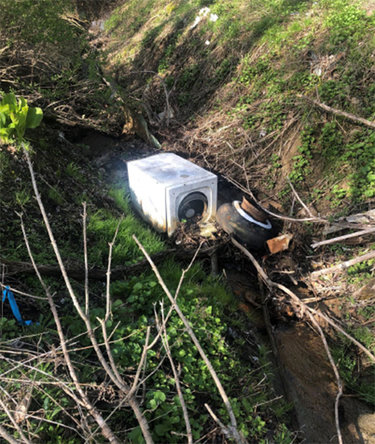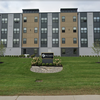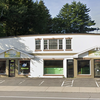Guilderland planners mull brownfield concerns at Foundry Square
— From Guilderland Village LLC submittal to the town of Guilderland
A photo taken on the site of the proposed Foundry Square Planned Unit Development. The location was once home to Master Cleaners, whose use of cancer-causing chemicals “has already impacted a tributary of the Hunger Kill and is in close proximity to the Hunger Kill and residential properties along Foundry Road.”
GUILDERLAND — The Guilderland Planning Board recently undertook what its chairman called a “general review” of a proposed Planned Unit Development at the corner of Foundry Road and Western Avenue.
“It’s really just looking at our concept layout. There’s really no heavy engineering that’s been done yet,” Chairman Stephen Feeney said during the board’s May 22 meeting. “This is just a look at density, type of use, height of the building, setbacks, parking,” although the board did hear about the laborious process needed to make the contaminated site habitable.
On May 7, the Guilderland Town Board voted unanimously to accept Guilderland Village LLC’s application for the proposed PUD, to be called Foundry Square, on 13 acres of land spread across five separate tax parcels between 2298 and 2314 Western Ave.
Guilderland Village, a limited liability company from the development team behind the luxury senior-living facility Hamilton Parc, is seeking approval from the town board to build two four-story buildings consisting of 285 apartments: 171 two-bedroom units and 114 one-bedroom units.
The town board is the lead agency for all proposed PUDs because they require a change in zoning.
Neither the proposed project’s height nor its density are allowed by town code.
Toward the end of the May 22 meeting, Town Planner Kenneth Kovalchik recommended that the planning board wait for comments on the proposal from the town-designated engineer before offering its opinion to the town board on the project.
Dealing with site contamination
During his presentation, the project’s engineer, Daniel Hershberg, explained to the board the process of decontaminating the brownfield site.
A brownfield, according to the state’s Department of Environmental Conservation, is defined as any real property where a contaminant is present at levels exceeding the soil cleanup objective or other health-based or environmental standards, criteria, or guidance adopted by the DEC, which said the former Master Cleaners site posed a significant threat to the public health and environment, and that cleanup of the soil and groundwater was required.
The site was added to the state’s list of designated brownfields in 2016.
The state is ready to step in and take over remediation of the site
The contamination is due to one of the project parcels once being the home to Master Cleaners, which was in operations from about 1956 through 1996. Albany County took title to the property in 2001, following a tax foreclosure. It was then purchased in September 2011 by current owner, Charles Bohl Incorporated.
Previous testing of the site found its “primary contaminants of concern” to be “chlorinated volatile organic compounds (VOCs), particularly tetrachloroethene (PCE), trichloroethene (TCE), and their breakdown products. PCE and TCE, widely used in fabric dry-cleaning, are nonflammable, colorless liquids at room temperature that evaporate easily into the air and emit an ether-like odor.”
On May 22, Hershberg said the contamination plume runs through the center of the former Master Cleaners building, “then loops around and goes all the way down to the stream course at the back.” A project memo submitted to the Guilderland Town Board by Kovalchik said the contamination “has already impacted a tributary of the Hunger Kill and is in close proximity to the Hunger Kill and residential properties along Foundry Road.”
To decontaminate the site, the applicant “could always excavate all the dirt and truck it off-site, but this stuff is now 15 feet in the ground and it runs into a clay layer,” Hersherberg said, “So we have to excavate all that area down to 15 feet deep and truck that off the site, which is neither economically feasible nor desirable. We’ll have all those trucks running back and forth across the streets to the places to dump them.”
Kovalchik’s project memo stated, “Chlorinated solvents are present in soil and groundwater at depths up to 15 feet below grade. Groundwater is present at shallow depths ranging from 1 to 6 feet below grade depending on the season and location. There is a distinct confining clay layer at the site ranging from 11 feet to 15 feet below grade that appears to be limiting the vertical migration of contaminants.”
So, rather than truck the contaminated soil off-site, Hershberg told the board on May 22, “We’ll use some chemical method. Oxidation is probably the way we’ll do it.”
Oxidation, he explained, is where “you put chemicals down that oxidize the chemicals in the ground, and that makes them inert. Then the problem goes away,” he said before adding, “I can’t commit to that plan yet because we still have to get the environmental review.”
But something needs to happen sooner rather than later, as the state appears ready to step in and take over cleanup of the site.
Theresa Bohl, the majority shareholder of Charles Bohl Inc., in a May 9 email to Kovalchik wrote that a representative from the DEC “shared details on how close the Department was in mobilizing contractors and taking over the cleanup because it is documented to be contaminated and there was no progress.”
Takeover plans were put on hold, Bohl wrote, “when The Markstone Group signed on” as project developer.
But “if the DEC were to take over the cleanup,” Bohl wrote, “it would be bad on all fronts, it would mean that they would have to first go through the county to take ownership of the property, eventually it would be up to the taxpayers to foot the bill. It would probably mean the property sitting vacant for a decade until this was resolved. There’s nothing good about that option.”
Housing
During the May 22 meeting, Feeney asked Hershberg if it was even possible to place housing on a remediated site. “Usually with brownfields, it’s like, ‘OK, you can only have the parking over that,’ but is this something that you can actually have residential uses over that remediated site?” Feeney said.
Hershberg said it was possible to have housing on the site if “you remediate to the level allowed for residential use.”
Hersherg explained there are different levels of remediation for commercial residential uses, which is based upon the parts per million left in the soil. So, he said, “If you do a good enough job of remediating, you can have a building over it.”
“So it’s a question of how much poison you leave in the land?” Hershberg was asked by one board member. “No,” Hershberg answered, stating that, when the chemicals interact with the chlorinated VOCs, they become inert.
He explained that, to remediate to a residential level, the VOCs have to get to almost undetectable levels. “But for commercial,” he said, “you can leave more in place,” adding that the goal was to mitigate to the maximum extent feasible.
Mitigating to a level allowable for residential, Hershberg said, “means essentially DEC has to say we’re not causing any further pollution to stream courses or any pollution in any area ….”



